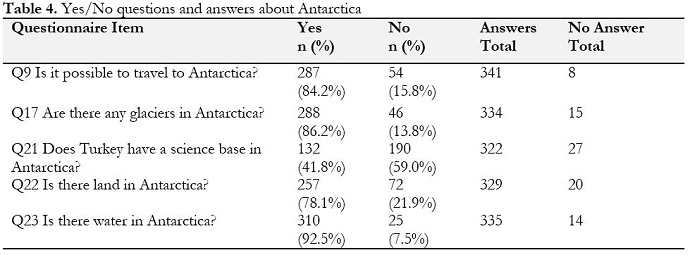
Determining Secondary School Students’ Knowledge and Awareness about Antarctica
Abstract
Full Text:
DOWNLOAD PDFReferences
Australian Science Teachers Association (ASTA). (2007). Antarctic Science. A resource book of ideas for teachers for National Science Week. https://asta.edu.au/generic/file-widget/download/id/1165.
Azzolini, R., Campus, P., & Weber, J. (2012). The polar ocean in a warming planet: Understanding for managing a unique resource of the humankind. EGU General Assembly Conference Abstracts, 14, 13660.
Bastmeijer, K. and Roura, R. (2008). Environmental impact assessment in Antarctica. In:Bastemejer, K. & Roura, R. Theory and Practice of Transboundary Environmental Impact Assessment. First Edition. Brill/Nijhoff, 175-219. DOI: doi.org/10.1163/ej.9789004164796.i-400.57.
Baydemir, T. (2019). Buzullardan öğreneceklerimiz var. Bilim ve Teknik Dergisi, 618.
Benayas, J., Pertierra, L., Tejedo, P., Lara, F., Bermudez, O., Hughes, K., and Quesada, A. (2013). A review of scientific research trends within ASPA No. 126 Byers Peninsula, South Shetland Islands, Antarctica. Antarctic Science, 25(2), 128-145. DOI:10.1017/S0954102012001058.
Benn, D. I. & Evans, D. J. A. (2010). Glaciers and Glaciation. Second Edition, Routledge, New York, USA.
Cohen, L., Manion L. & Morrison, K. (2007). Research Methods in Education. New York, NY: Routledge.
Dahl-Jensen, D. (2018). Drilling for the oldest ice. Nature Geoscience, 11, 702-706.
Drake, M. J. (2015). Origin of water in the terrestrial planets. Meteoritics and Planetary Science, 40(4), 1–9.
Drewry, D.J. (2009). The future of Antarctic scientific research. Polar Record, 29(168), 37-44.
Elkins-Tanton, L. T. (2011). Formation of early water oceans on rocky planets.Astrophysics and Space Science, 332(2), 359–364. DOI: 10.1007/s10509-010-0535-3.
Garcia, C. V., Robertson, W.H., Lougheed, V., Tweedie, C. & Velasco, A. (2013). Journey to the End of the Earth: Academic and Professional Benefits for Students Participating in a Field-Based Research Program in Antarctica. Journal of College Science Teaching, 42(4), 72-81.
Genda, H. (2016). Origin of Earth’s oceans: An assessment of the total amount, history and supply of water. Geochemical Journal, 50(1), 27–42. DOI: doi.org/10.2343/geochemj.2.0398.
Gröndahl, F., Sidenmark, J. & Thomsen1, A. (2009). Survey of waste water disposal practices at Antarctic research stations, Polar Research, 28(2), 298-306. DOI: 10.1111/j.1751-8369.2008.00056.x
Karahalil, M., Özsoy, B., Oktar, Ö., Yirmibeşoğlu, S. & Vural, D. (2018). Türkiye’de kutup bölgeleri hakkında farkındalığı arttırmak üzere yapılan çalışmalar. II. Kutup Bilimleri Çalıştayı Özet Kitabı, 86, 12-13 Eylül, İsanbul-Türkiye.
Karataş, F. Ö., Köse, A. G. S. & Coştu, A. G. B. (2003). Öğrenci Yanılgılarını ve Anlama Düzeylerini Belirlemede Kullanılan İki Aşamalı Testler. Pamukkale Üniversitesi Eğitim Fakültesi Dergisi, 13(13), 54-69.
Kaya, E. (2012). İlköğretim öğrencilerinin küresel konumlandırma becerileriyle medyadan yararlanma durumları ve sosyal bilgiler dersindeki başarıları arasındaki ilişki. Türkiye Sosyal Araştırmalar Dergisi, 16(2).
Lucchitta, B.K. & Fergusson, H.M. (1986). Antarctica: Measuring glacier velocity from satellite images. Science, 234(4780), 1105-1108. DOI: 10.1126/science.234.4780.1105.
Marty, B. & Yokochi, R. (V). Water in the early Earth. Reviews in Mineralogy and Geochemistry, 62(1), 421–450. DOI: doi.org/10.2138/rmg.2006.62.18
McFadyen, E. (2011). Antarctic Future – Education Learning about Antarctica in the 21st Century. A review of selected education resources available to primary teachers. University of Canterbury, Postgraduate Certificate, Postgraduate Certificate in Antarctic Studies.
Özbebek Tunç, A., Akdemir Ömür, G. & Düren, A. Z. (2013). Çevresel Farkındalık. İ.Ü. Journal of Faculty of Political Science, 0(47), 227-246.
Palmer, J.A. & Suggate, J. (2004) The development of children’s understanding of distant places and environmental issues: report of a UK longitudinal study of the development of ideas between the ages of 4 and 10 years. Research Papers in Education, 19(2), 205-237.
Ricci, C. A., & Egerton, P. (Eds.). (2010). European research in the polar regions: Relevance, strategic context and setting future directions in the European research area (EPB Strategic Position Paper). European Science Foundation.
Robert, F. (2001). The origin of water on Earth. Science, 293(5532), 1056–1058. DOI:doi.org/10.1126/science.1064051.
Salazar, J.F. (2012). Perceptions and opinion of Antarctic values in Chile. In Liggett, D. & Hemmings, A.D (Eds.) Exploring Antarctic Values. Christchurch: University of Canterbury, Gateway Antarctica Special Publication Series.
Shabudin, A. F. A, Rahim, R. A. & Ng, T. F. (2016). Strengthening scientific literacy on polar regions through education, outreach and communication (EOC). International Journal of Environmental & Science Education, 11(12), 5498-5515.
The National Academy of Sciences (NAS). (2011). Future Science Opportunities in Antarctica and the Southern Ocean, The National Academies Press: Washington DC.
Tuna, F., Demirci, A. & Gültekin, N. (2012). Temel coğrafi bilgi ve beceriler toplumda ne ölçüde kullanılıyor? Yön, konum ve harita becerilerinde mevcut durum analizi. Milli Eğitim, 195, 211-227.
Ursavaş, N., & Aytar, A. (2018). Okul öncesi öğrencilerinin su farkındalığı ve su okuryazarlıklarındaki gelişimin incelenmesi. Journal of Research in Informal Environments, 3(1), 19-45.
USGS (2020). How much of the Earth's water is stored in glaciers? https://www.usgs.gov/faqs/how-much-earths-water-stored-glaciers?qt-news_science_products=0#qt-news_science_products.
Vural, D., Yirmibeşoğlu, S., Oktar, Ö. & Özsoy, B. (2018). Kutup bölgelerindeki bilimsel araştırmaların eğitim ve farkındalık çalışmalarına etkisi, II. Kutup Bilimleri Çalıştayı Özet Kitabı, 76, 12-13 Eylül, İsanbul-Türkiye.
Wu, J., Desch, S. J., Schaefer, L.,Elkins-Tanton, L. T., Pahlevan, K. & Buseck, P. R. (2018). Origin of Earth’swater: Chondritic inheritance plusnebular ingassing and storage of hydrogen in the core. Journal of Geophysical Research: Planets, 123(10), 2691–2712.
DOI: https://doi.org/10.17509/jsl.v4i1.27537
Refbacks
- There are currently no refbacks.
Copyright (c) 2020 Nazihan Ursavas, Raif Kandemir

This work is licensed under a Creative Commons Attribution-ShareAlike 4.0 International License.


Jl. Dr. Setiabudhi 229 Bandung 40154, West Java, Indonesia











